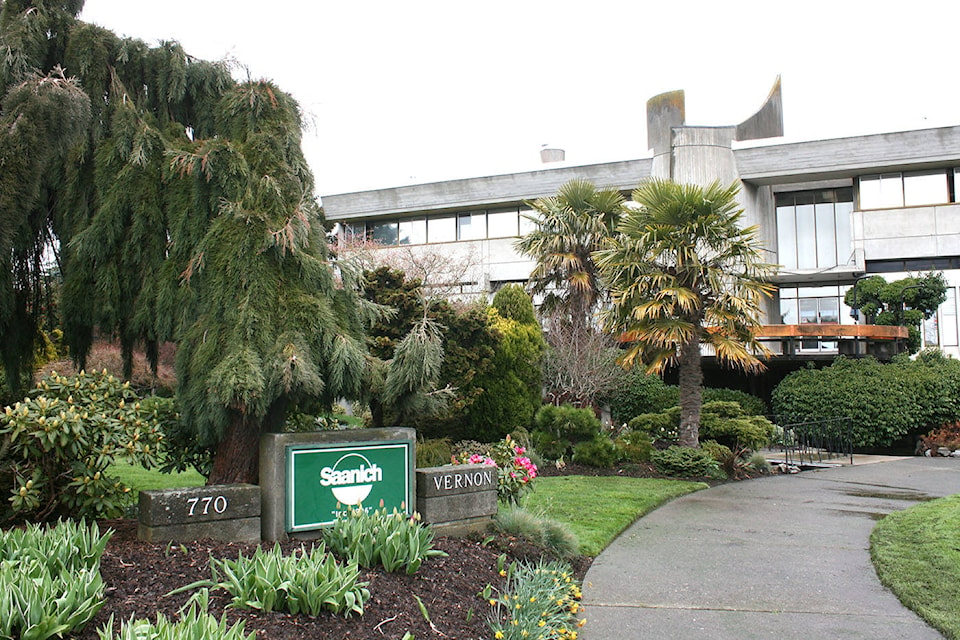Business Wanted.
That is the message Coun. Colin Plant Saanich believes should send out — otherwise the community will face some difficult financial choices in the future.
“Saanich will eventually have to look at cutting services, if it does not grow its revenues because eventually people will reach a point where they may not be able to afford living here,” said Plant. He made those comments after Saanich Wednesday unanimously approved its 2017 budget.
It raises revenues from property taxes by 3.53 per cent. This figure means that the owners of average Saanich homes valued at $750,000 will pay an additional $86 in property taxes. “That is not likely going to break the metaphorical camel’s back, but it is adding pressure,” said Plant.
Saanich, he said, needs to do more to allow development and attract business because the current ratio between taxes from residential properties and businesses is unsustainable.
“Currently Saanich’s tax breakdown is 23 per cent business and 76 per cent residential,” he said. “We need to grow the former number. While Saanich is and will likely always be a residential municipality with commercial villages, I believe it needs to grow that 23 per cent [figure] by a few percentage points.”
Plant said he specifically wants to see more housing development in Saanich’s major centres and corridors. Plant also said he would like to see Saanich support more businesses in the information technology sector and attract more light manufacturing to its industrial areas.
Plant raised these issues after what he described was a “long, arduous and often painful [budget] process” that climaxed yesterday as council considered various options. Saanich residents heard earlier this month that council was trying to shave 1.5 per cent off a looming tax of 4.45 per cent, while reconciling requests for additional staffing.
Chief administrative officer Paul Thorkelsson had earlier told council Saanich confronts “significant capacity gaps…primarily as the result of fiscal restraint policy decisions since 2008.” While this approach has had positive financial effects, it has left Saanich in its “current state” defined by informal service reductions and increasing frustration from council and some members of the community about “time, cost and quality of municipal services.”
Saanich, Thorkelsson said in a later report, has the lowest per capita expense compared to similar municipalities across the province and ranks somewhere in the middle among muncipalities in the Capital Regional District (CRD), below Central Saanich, Sidney, Esquimalt, Oak and Victoria.
While Plant said he initially planned to vote against the budget, he reconsidered during the course of deliberations.
“I struggled with this decision and initially was going to vote against the proposed budget because I did not think we had worked hard enough and found the savings needed to reduce the lift,” he said in a Facebook page shortly after the budget.
Plant however also noted as a matter of transparency, that he was also in favour of “adding all the critical staffing requests that would have seen us land at the same amount had my suggestions gone through.”
Council, he said, ended up approving about half of those.
This said, Plant used the conclusion of budget deliberations to make some pointed remarks about Saanich’s long-term financial sustainability in his Facebook post.
“What is [incredibly] important and clear to me is that we must increase our revenues in a more diverse way than simply asking our homeowners to ‘pay the freight’ each year,” he said.
Saanich needs to grow its business base in looking at ways to increase development, he said. “Clearly our expenses are outpacing our revenues and we are not sustainable at having increases of double inflation,” he said.
Plant later clarified this comment. “I’m not suggesting by any stretch that Saanich is going to go bankrupt — we are not,” he said. “We are incredibly prudent in our budgeting, but our residents are being asked to pay increases above inflation and that eventually will become unsustainable. Growing the commercial tax base is an obvious way to combat this.”
Overall, Saanich’s budget amounts to $265.9 million, with $173.9 million going to operations and $92 million to capital.
Breaking down the 3.53 per cent increase, 2.29 per cent support current levels of municipal and police operations; .86 per cent support capital infrastructure replacement; .28 per cent cover resource requests; and .10 per cent go towards the Greater Victoria Public Library.
Council will consider and adopt the necessary financial plan and tax rate bylaws May 8 and May 10. Saanich will mail out tax notices to all property owners before the end of May.
